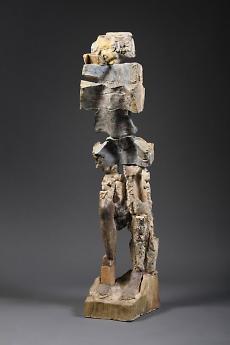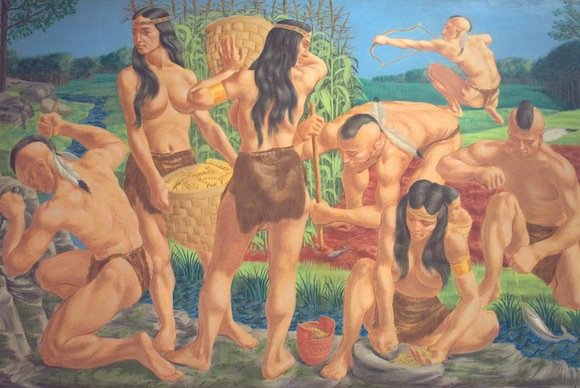George Eastman House presents The Unseen Eye: Photographs from the W.M. Hunt Collection, on view from October 1, 2011 through February 19, 2012 in the Brackett–Clark Gallery.
All eyes will be on George Eastman House International Museum of Photography and Film this fall as it presents the largest exhibition in its history — The Unseen Eye: Photographs from the W.M. Hunt Collection. More than 500 photographs by the masters of the medium will be on view. The Eastman House is dedicating all of its primary gallery space to this exhibition.
 Earlier this year The New Yorker referred to the collector as “the legendary W.M. Hunt.” He is a renowned curator and dealer who has been collecting photographs for 40 years. A self-described “champion of photography,” he is well-known for his “eye” and sense of humor. Hunt describes the collection as “magical, heart-stopping images of people in which the eyes cannot be seen.”
Earlier this year The New Yorker referred to the collector as “the legendary W.M. Hunt.” He is a renowned curator and dealer who has been collecting photographs for 40 years. A self-described “champion of photography,” he is well-known for his “eye” and sense of humor. Hunt describes the collection as “magical, heart-stopping images of people in which the eyes cannot be seen.”
The photographs of The Unseen Eye have a common theme — the gaze of the subject is averted, the face obscured, or the eyes firmly closed. The images evoke a wide range of emotions and are characterized, by what, at first glance, the subject conceals rather than what the camera reveals.
Eastman House will present the first major U.S. exhibition of the collection, of which APERTURE is simultaneously publishing a book titled The Unseen Eye: Photographs from the Unconscious, to be released in October. Highlights from the collection have previously been seen in Europe at the Rencontres de la Photographie in Arles, France; the Musée de l’Elysée in Lausanne, Switzerland; and Foam-Fotografiemuseum in Amsterdam, The Netherlands.
“This collection and exhibition represent a very personal journey for me,” Hunt said. “It is my unconscious made manifest. These are all photos of me. But they’re all of you, too. They are evocative, whimsical, representational, many things. I love the mystery of it. You have to react, to come to the image, to make up your own story.”
The collector’s first purchase was an Imogen Cunningham photograph, in which the subject’s eyes are veiled and unseen by the camera. This now extensive collection of haunting photographs reflects Hunt’s surreal vision and includes The featured photographs include Andre Breton’s self-portrait with eyes closed, Weegee’s multi-imaged portrait of Andy Warhol in sunglasses, the breakthrough news photo of Ruth Snyder in the electric chair in 1928, and Robert Mapplethorpe’s photographs of artist Alice Neel shortly before her death. Vintage and contemporary black and white images join photography in vibrant colors to create a picture of humanity from birth to death, from the banal to the transcendent.
The featured works range from daguerreotype to digital by photographers such as Berenice Abbot, Richard Avedon, Robert Frank, Lee Friedlander, Annie Leibovitz, Robert Mapplethorpe, Irving Penn, Many Ray, Edward Steichen, Edward Weston, and Joel-Peter Witkin, as well 19th-century work from Nadar, Alinari, and Roger Fenton. The whole range of photographic processes as well different formats is featured via the 500 photographs, selected from the 1,500 images in the collection. The most recent acquisition is a triptych of film stills from Jean-Luc Godard’s “Le Petit Soldat”. The largest is a hand colored self-portrait by the Dutch artist, Teun Hocks, and the smallest is a photo-booth self portrait by the Surrealist Andre Breton. The oldest object is a gravure of the Shroud of Turin by Secondo Pio.
The exhibition also includes work by contemporary photo-based artists — some of whom have not yet been shown at Eastman House — such as Mitch Epstein, Steven Klein, and Kiki Smith Hunt is a long-time supporter of emerging talent. He selected a portrait by Carrie Levy as the cover image of his book’s U.S. version. As a dealer he introduced talents such as Elinor Carucci, Luc Delahaye, Michael Flomen, Bohnchang Koo, Luis Mallo, Erwin Olaf, and Paolo Ventura, and as a writer he has worked with Bill Armstrong, Mark Beard, Manuel Geerinck, and Jeff Sheng — all of whom are represented with work in the collection and exhibition.
The Unseen Eye exhibition features little wall text, but it does include video commentaries by Hunt, with personal responses to these images gathered over many years and his insights into the psychology of collecting.
Eastman House will feature a small accompanying exhibition of “unseen eyes” selected by Hunt from the museum’s unparalleled permanent collection. These range from Dorothea Lange’s 1933 photograph “White Angel Bread Line,” to an unattributed 1850 daguerreotype of a blind man holding a cat. A related online exhibition will include hundreds of vernacular photographs — snapshots — from Hunt’s collection.
About W.M. Hunt
W.M. Hunt has had a long relationship with Eastman House and is a champion of photography — a collector, curator, consultant, writer, teacher, and fundraiser who lives and works in New York City. He was a founding partner of the prominent photography gallery HASTED HUNT in Chelsea, Manhattan and served as director of photography at Ricco/Maresca gallery. His upcoming book The Unseen Eye: Photographs from the Unconscious (Aperture) focuses on Collection Dancing Bear, currently his largest collection of photographs.
He and his collecting have been featured in The New York Times and The Art Newspaper as well as on PBS and YouTube.
He is a professor at the School of Visual Arts and on the Board of Directors of the W. Eugene Smith Memorial Fund and The Center for Photography at Woodstock, N.Y., where he was the recipient of their Vision Award in 2009. He also served on the Board of Directors of AIPAD (Association of International Photography Art Dealers) and as chairman of Photographers + Friends United Against AIDS.
Image: Carrie Levy. Untitled, from Domestic Stages, 2004.
www.eastmanhouse.org



